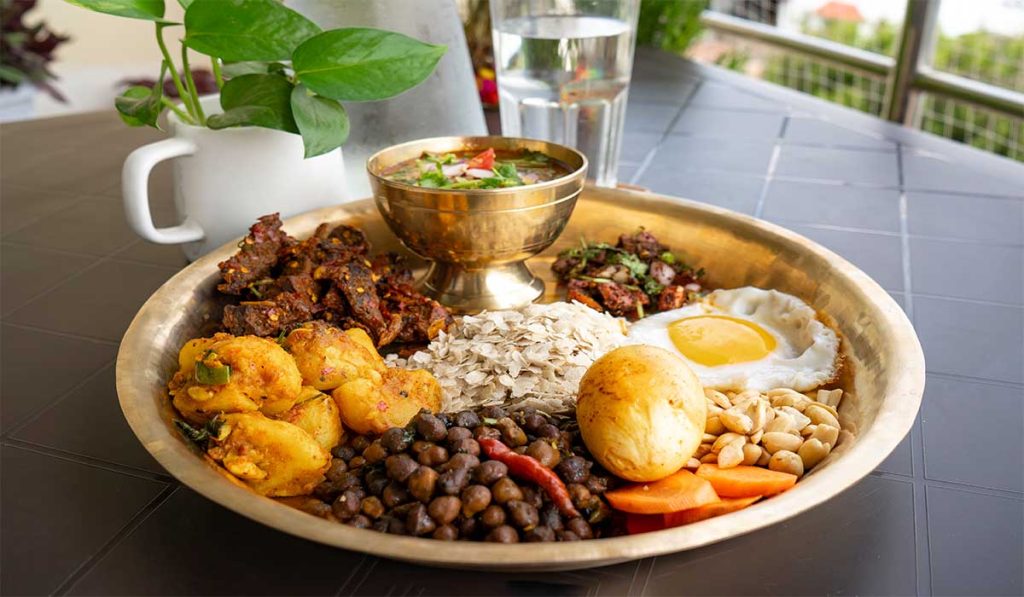The Langtang Trek is one of the convenient treks, which rewards the trekkers with panoramic Himalayan vistas, along with a unique culture. The trek follows the teahouse system, where the family-run lodges provide rooms, meals, and warmth for trekkers. Beyond being a business, the teahouses are also a support system for local families and create an authentic lifestyle.
Accommodation facilities vary with altitude. At lower elevations, they feature attached bathrooms, hot showers, and wider menus, offering comfort and convenience. As you climb higher, the facilities become simpler. That means the rooms are smaller, bathrooms need to be shared, and hot water is limited. Despite the simple and basic facilities, the friendly and cozy rooms provide a warm experience.

The teahouses typically offer twin-sharing wooden rooms with mattresses, blankets, and pillows. The cost usually varies from $5 to $10 per night, and it is often cheaper if you take meals at the same lodge. The accommodation cost increases and ranges between $10 and $15 at the lavish lodges and hotels at the lower altitudes.
Each teahouse along the trail reflects local culture and offers hearty meals like dal bhat, momos, and noodles, along with a chance to connect with the people of Langtang.
Accommodation on the Langtang Trek blends cultural immersion and humble comfort. It also provides rest, warmth, and a window into the valley’s daily life, making each overnight stop a memorable part of the Himalayan adventure.
What to Expect From Teahouses On The Trek
Though every teahouse and hotel on the Langtang trek varies in size and resources, every trekker expects clean and warm rooms with good bedding and meals. All they want is comfort and facilities during the Langtang Valley Trek. Here are some key aspects:
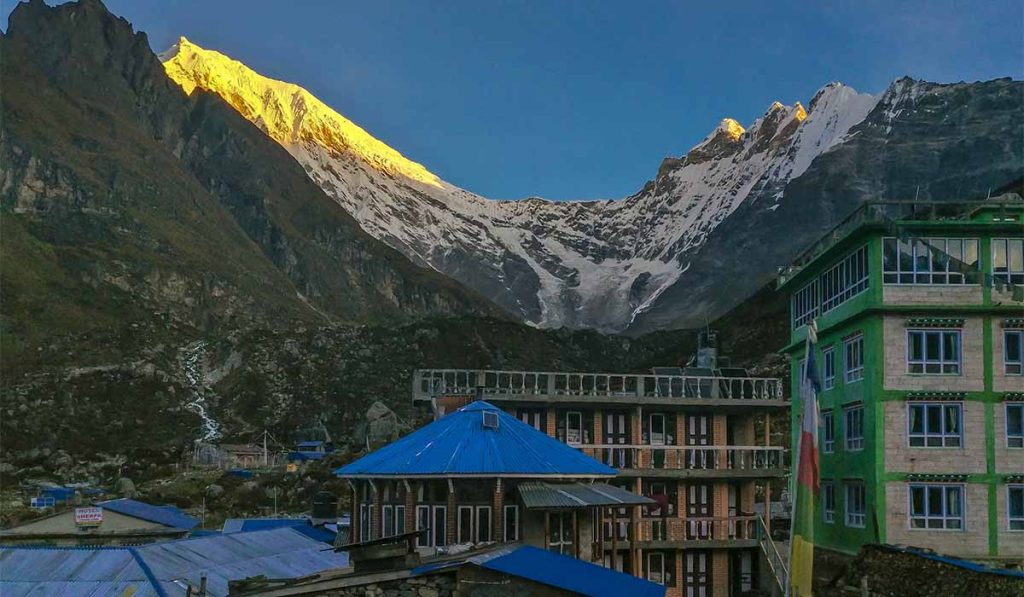
Room setup (Beds, Blankets, Shared Rooms)
Trekkers expect well-prepared rooms for overnight stays. Since Langtang is a cold region, shared rooms with proper bedding and warm blankets are essential. These simple comforts add a sense of coziness and help make the trek more enjoyable.
Toilets and Showers (Attached vs. Shared, Hot Shower Availability)
Bathrooms in most teahouses are shared, with either squat or Western-style toilets. In a cold region like Langtang Valley, trekkers appreciate hot showers to warm up after a long day. Hot water is widely available in lower regions, but at higher elevations, water may be limited. On average, a hot shower costs $1.5–$4.
Common dining halls
Dining halls are central to the teahouse experience, offering both meals and social interaction. After a long day on the trail, trekkers can rest, eat, and share stories with fellow hikers, making these spaces lively and communal.
Electricity, Wi-Fi, and charging facilities
Electricity and Wi-Fi are increasingly expected by trekkers. Larger villages like Kyanjin Gompa and Langtang Village typically offer Wi-Fi, and most teahouses have electricity. Charging devices may require a small fee, but these facilities help trekkers stay connected and powered throughout the trek.
Food And Dining In Langtang Teahouses
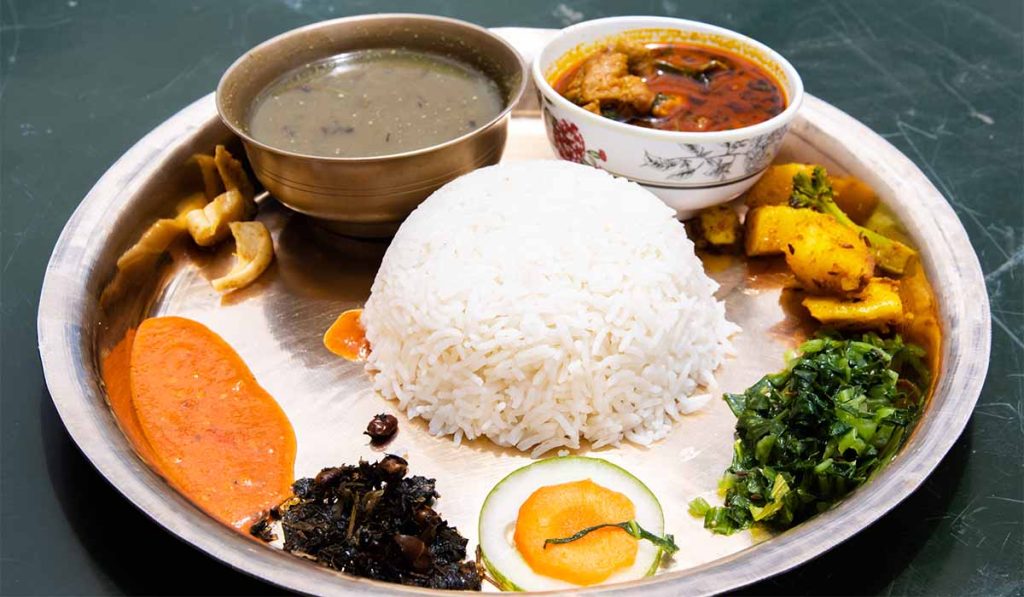
Food and dining are essential parts of any trek. So, every trekker naturally expects good meals and comfortable dining spaces along the way. Teahouses throughout the Langtang Valley mostly offer similar dishes. The dishes primarily offered here are Nepali staples like dal bhat, noodles, and momo.
Breakfast options are usually varied. They include Tibetan bread, chapati, porridge, pancakes, muesli, eggs, and tea or coffee. For long trekkers, many teahouses also prepare packed lunches.
Dietary preferences are generally well accommodated. Vegetarians have no issues, as most high-altitude meals are plant-based. Non-vegetarians can enjoy meat dishes in the lowlands, but meat becomes rarer as you ascend to higher altitudes.
Meal prices increase with elevation. In lowland Syabrubesi, dal bhat costs $4–$6, rising to $6–$9 at higher stops. Breakfast typically ranges $3–$6, while extra dishes like noodles, fried rice, or momo cost $4–$7, and tea or coffee averages $1.5–$3.5.
Purified bottled water is available for $1–$3. The increasing prices at higher altitudes reflect the challenges of transportation and porter effort in these remote areas.
Accommodation at Major Stop Points Along The Langtang Trek
Along the Lantang Trek, trekkers pass through several major stop points. As you gain altitude, the landscape and accommodation options gradually change. As such, there are differences in food, facilities, and comfort levels. Here is a look at key stop points.
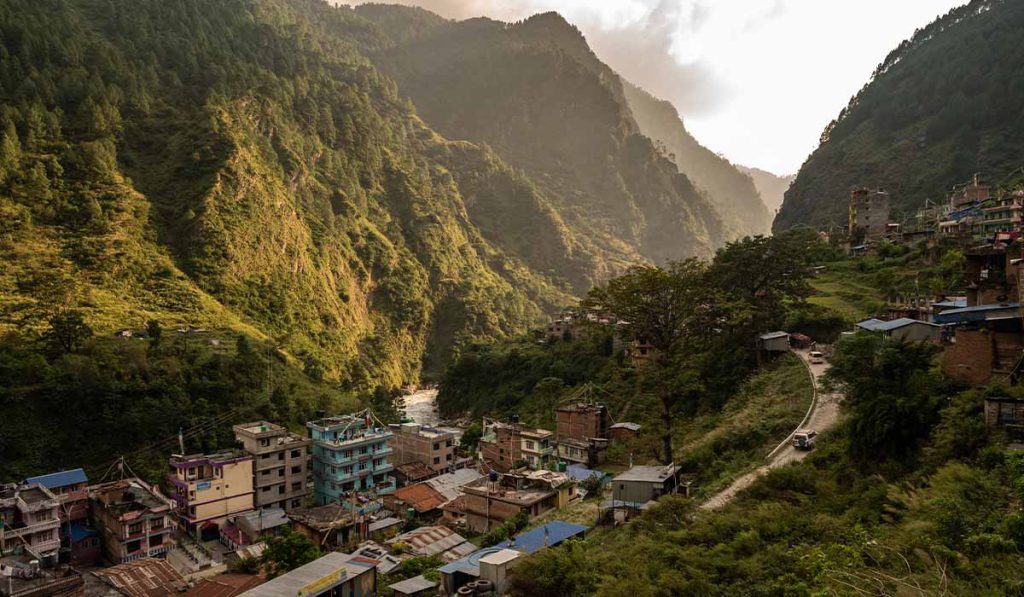
Syabrubesi (1,550 meters)
Syabrubesi is the starting point or entry point of the Langtang Trek, nestled at an altitude of 1,550 meters. It is also the last road-accessible village before entering the mountains, making it a convenient place for trekkers to rest after the long drive and prepare for the journey.
The accommodation in Syabrubesi is comparatively better than in other parts of your Langtang Trek. The village has a large population, so facilities are better and generally more affordable.
You’ll find guesthouses, small lodges, and hotels here. Most rooms are clean, with twin beds, and some even offer private bathrooms. Wi-Fi is also available at many places, adding to the comfort and convenience for trekkers before they head deeper into the valley.
Lama Hotel (2,470 meters)
Lama Hotel only sounds like a single hotel located at an elevation of 2,470 meters. But it is not one hotel. Instead, it is a small cluster of teahouses and hotels in a forested area of the Langtang region. This is usually the first overnight stop for the trekkers on their trek.
The accommodation at Lama Hotel is basic, with wooden rooms, shared toilets, and limited hot water. Expect a rustic and peaceful atmosphere, surrounded by dense pine and rhododendron forests. You may feel remote, and the evenings are often quiet, except for the gushing sound of the river flowing nearby.
Riverside / Ghodatabela (3,030 meters)
Ghodatabela is often considered a lunch stop at an elevation of 3,030 meters. But some trekkers choose to stay overnight if they are tired. The lodges here are very simple, with rough wooden construction and minimal facilities. Rooms are basic and bathrooms are shared. You can view the stunning, snowy Langtang range, which gives a first taste of the higher Himalayan landscape on your Langtang journey.

Langtang Village (3,430 meters)
Langtang Village is a historically special place on the Langtang journey, at an elevation of 3,430 meters. It was devastated by the 2015 earthquake in Nepal and subsequent landslide, but it has since been rebuilt with stronger lodges. Today, trekkers find multiple teahouses with improved facilities, warm dining halls and cozy rooms. The sense of resilience and community here is noticeable, and staying in Langtang Village allows trekkers to connect with locals who have worked hard to restore their homes. The lodges are welcoming and the atmosphere often feels communal, as trekkers gather to share stories of the day.
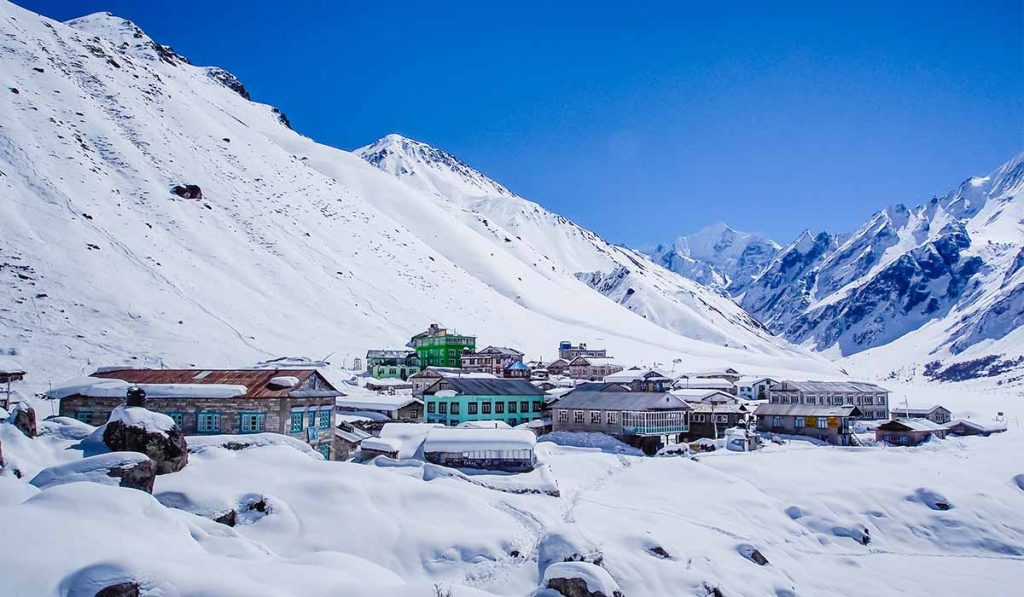
Kyanjin Gompa (3,870 meters)
Kyanjin Gompa is the most famous and important place of the Langtang trek, located at an elevation of 3,870 meters. It is popular with the best teahouses and hotels with spectacular accommodation in the iconic location. The teahouses in Kyanjin Gompa have attached bathrooms and solar-heated showers. Some of the teahouses and hotels feature extended menus that even include bakeries.
You can easily find apple pie, cinnamon rolls or yak cheese at Kyanjin Gompa, a delightful treat after days of trekking. Kyanjin Gompa is also the main acclimatization stop, with popular side hikes to Kyanjin Ri and Tserko Ri offering panoramic views of snowy peaks. Many trekkers spend two nights here to rest, acclimatize, and soak in the scenery.
Comfort vs Altitude: How Facilities Change As You Climb
The comfort in every accommodation varies, from the low altitudes with the lavish hotels having more and better amenities to the homestays and teahouses having simple and basic facilities at high altitudes.
At lower elevations like Syabrubesi, you can find lodges and hotels with attached bathrooms, hot showers, and reliable electricity. As you climb higher, the level of lavishness and comfort drops, rooms becoming simpler with the shared bathrooms. Also, the showers are often bucket-style with limited hot water at the higher altitudes due to the less facilities.
Syabrubesi offers the best comfort at the lowest price, Lama Hotel and Ghodatabela provide just the essentials, and Langtang Village balances comfort with authenticity. Despite the higher accommodation cost at Kyanjin Gompa, it becomes the most comfortable and rewarding stop for the trekkers. Kyanjin Gompa provides the most beautiful visuals of the Himalayas on your Langtang journey.
At the higher altitudes like Langtang Village, facilities are the most basic and limited, but the reward is the raw beauty of the surrounding mountains. The Himalayan trekking at high altitude may have less luxury but adds more authenticity to the reward of raw and beautiful scenes of snowy mountains.
Accommodation Cost Breakdown
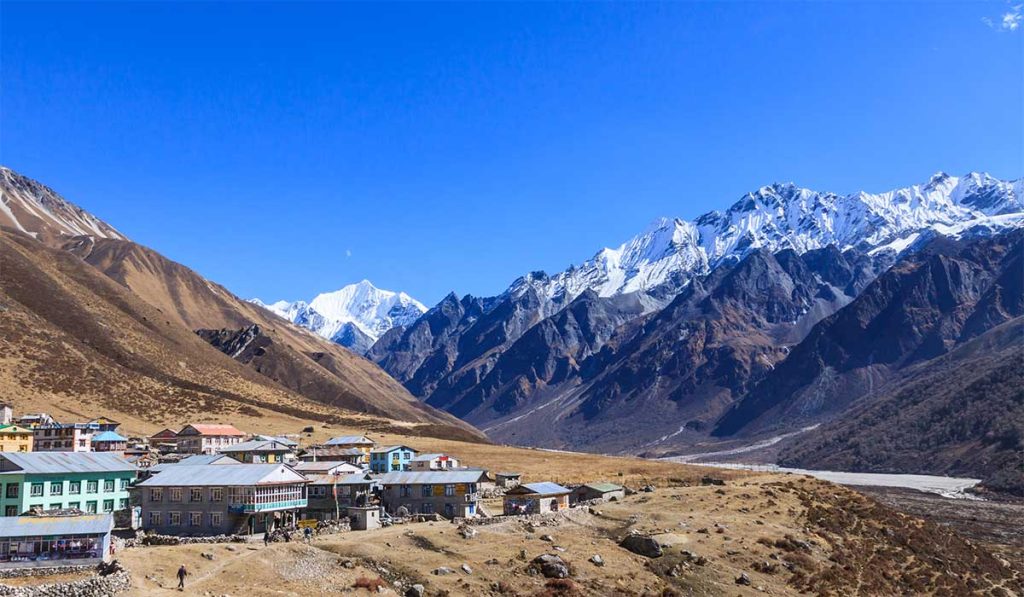
The accommodation cost varies in the Langtang region, ranging from the higher costs of well-equipped hotels in lower villages to affordable teahouses with basic facilities. You can find lavish hotels and lodges with good comfort and better facilities at the lower altitude places like Syabrubesi. While the level of comfort and facilities fluctuates when you climb up.
In Syabrubesi, located at an elevation of 1,550 meters, the food menu is quite varied, with choices ranging from dal bhat to noodles, fried rice, and snacks. Prices are also the most affordable in Syabrubesi. Here, the rooms cost between $8 and $15 per night, along with meals like dal bhat or noodles, costing between $4 and $6.
As you ascend to Lama Hotel, the comfort level drops noticeably. The hotels and teahouses provide basic facilities. Hot showers may be available for an extra charge of $3 to $4, while Wi-Fi is typically not included. Meals remain basic and simple, which focus on dal bhat, noodles, and momos, with slightly higher prices than in Syabrubesi. An overnight stay in Lama Hotel typically costs around $6 to $10.
At Ghodatabela, accommodation becomes even more rustic and simple. The Ghodatabela is often used as a lunch stop during the trek. However, a few trekkers spend the night in the limited teahouses available due to personal reasons, such as health issues and acclimatization problems.
Rooms are minimal, blankets are thin, and toilets are shared, often outdoors. Charging facilities are rare, and hot showers are usually unavailable. An overnight stay costs here range from $5 to $8, while meals like Dal Bhat or soup range from $5 to $7.
The situation improves slightly at Langtang Village, which was rebuilt after the 2015 earthquake. The lodges here are well built and offer good comfort compared to the mid-altitude stops. Trekkers can find cozy rooms, warmer blankets, and even attached bathrooms in some hotels and lodges.
Additionally, menus expand to include fried rice, momos, bread, and eggs with the staple dal bhat. Hot showers ($3 to $5), Wi-Fi ($2 to $3), and electronic device charging ($2 to $3 per device) are generally available. The room prices in Langtang Village are around $7 to $12, and meal costs range from $6 to $8.
Finally, at Kyanjin Gompa, trekkers can experience the best comfort during their entire Langtang journey. Some lodges provide attached bathrooms and a variety of foods. Hot showers ($4 to $5), Wi-Fi ($3 to $5), and device charging ($3 per hour/device) are widely available. The cost of rooms at Kyanjin Gompa is the highest on the Langtang trek, and ranges between $10 and $20. Besides, meals cost between $7 and $9.
Tips For Choosing Accommodation On The Langtang Trek
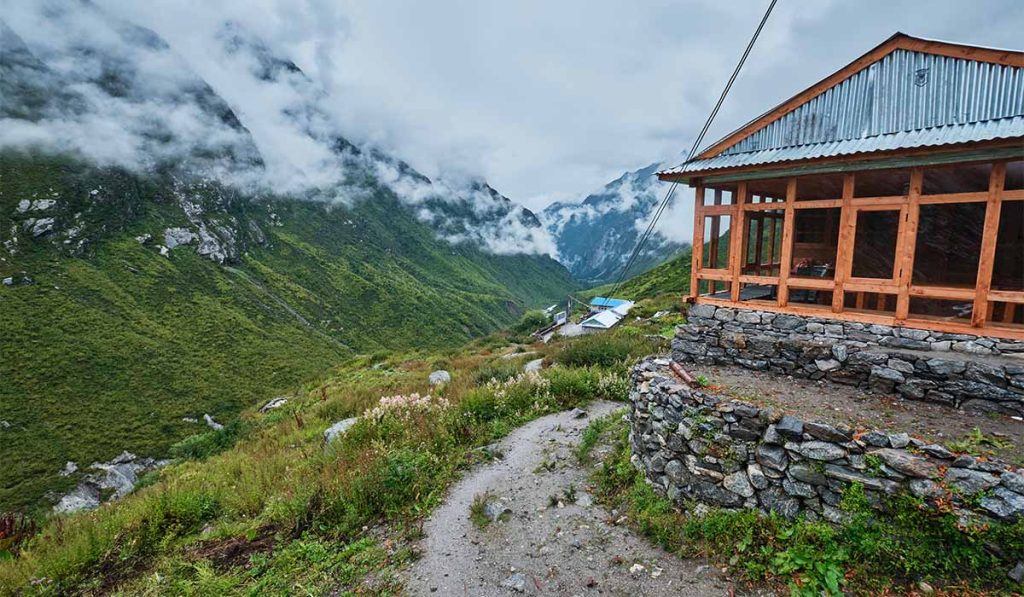
You should choose the proper accommodation with comfort, safety, warmth, and convenient rest, and meals for the trek. So, here are some tips you should follow while choosing accommodation on the Langtang Trek:
Booking in advance vs. walk-in
You may not get proper hotels and lodges with good facilities to stay warm and safe, especially in the peak seasons. So, it is best to book the tickets and hotel rooms in advance when you trek in the spring and autumn seasons.
When you trek in off-season, the walk-in bookings can work. However, advanced booking is generally recommended.
Peak season vs. off-season availability
The season of your trek greatly affects accommodation options. In peak season, advanced booking ensures you get well-equipped lodges and hotels. Without advanced booking, quality accommodation can be limited.
During the off-season, you can still find good lodges, but views and facilities may be limited compared to peak season.
Staying warm in teahouses (extra blankets, sleeping bag advice)
Bring extra warm blankets, a sleeping bag, and warm clothes. You may not get heating facilities in every hotel, teahouse, or lodge. Being prepared makes sure you stay comfortable during cold nights
Expect Basic Facilities
As you climb higher, facilities become simpler and more basic. Adjusting your expectations to match the altitude changes will help you enjoy the trek and create unforgettable memories along the way.
Hospitality And Local Experience
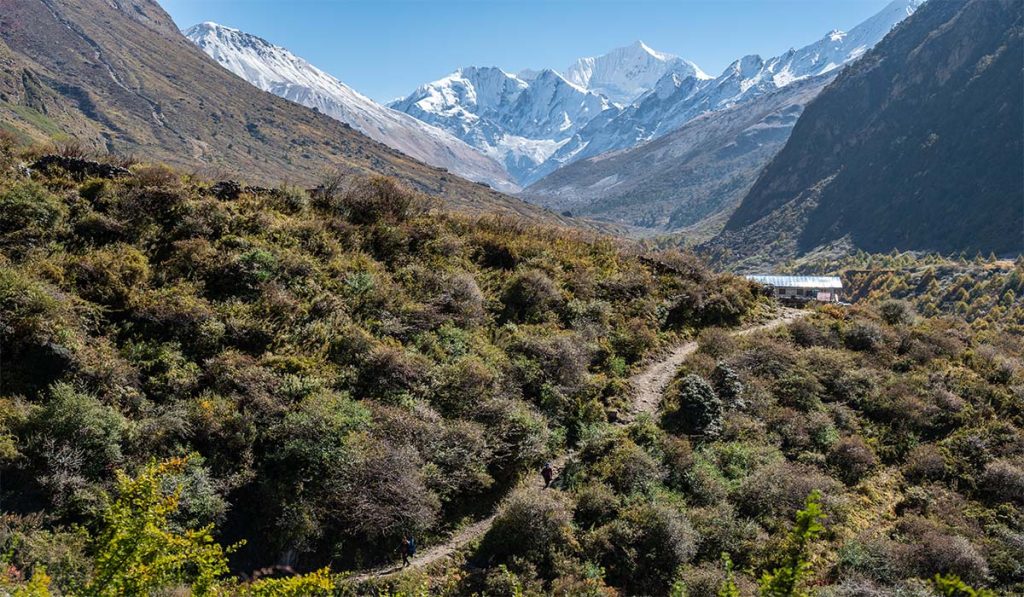
Overnight stays here in Langtang villages and hotels reward you with the warm and genuine hospitality, with the unique local culture. Accommodation here gives you the chance to connect with the local communities. Conversations with lodge and hotel owners provide a glimpse into the culture, traditions, and history of the Langtang Valley.
Most of the lodges and hotels in Langtang are family-run, while a few are run by other people outside the Valley. Regardless, the locals always warmly welcome the trekkers into their daily lives. These teahouses are not just places to sleep or rest. They also support the local economy and help communities rebuild and thrive after hardships such as the 2015 earthquake. Tourism in the Langtang region has been the main source of income for many locals to use as bread and butter in their daily lives.
Packing Tips To Make Stays More Comfortable
The following packing tips can make your trek more comfortable and memorable:
- Carry warm sleeping bags and clothes, especially when travelling to high altitudes over 3,000 meters and teahouses without heating facilities.
- Bring one fully charged, as charging facilities may not be available everywhere, and when available, can be expensive.
- Pack the extra comforts like slippers, snacks, and toiletries for your pleasant stay in modest teahouses.
Final Thoughts

Accommodation on the Langtang trek is not only about luxury, but also about simplicity and authenticity, offering the Himalayan hospitality. While comparing the Everest Base Camp and Annapurna Base Camp Trek, the Langtang Trek is a less commercialized and underrated trek.
Langtang Trek doesn’t offer any luxury hotels and teahouses like the EBC and ABC treks do. However, it doesn’t disappoint in Himalayan hospitality and Himalayan scenarios. The cozy lodges and hotels in the lower Langtang region turn to the basic and rustic teahouses gradually, as trekkers climb up. And finally, trekkers find the comfortable and well-rebuilt hotels and lodges of Langtang Village. Later, surprisingly, at a higher altitude of Kyanjin Gompa, there are well-equipped hotels.
Despite having the basic facilities in the higher altitudes, the local communities don’t make trekkers feel bad, welcoming them with warm hospitality. They have saved their unique culture alive for centuries.
Trekkers should come prepared for the basic conditions of the Langtang region. They should carry warm sleeping bags, budget for extra costs like hot showers and Wi-Fi, and adjust expectations as altitude increases. In return, the reward is unforgettable memories, genuine human connection, and a sense of accomplishment.
The Langtang Trek experience goes far beyond merely finding a place to sleep. It rewards trekkers with the resilience and generosity of the Langtang people, creating unforgettable Himalayan memories.
Ultimately, accommodation on the Langtang Valley trek is not just a shelter. It is an integral part of the journey. It shapes the rhythm of each day and adds to the cultural and emotional richness of the trek. Staying in these teahouses allows you not only to rest but also to immerse yourself in the life of the valley, making every overnight stop a meaningful part of the adventure.
